Dun Laoghaire Golf Club - Hosts of the Curtis Cup

Greenside's Alan Mahon paid Course Superintendent Des McGann a vist ahead of the tournament
In 1909, fifty-one residents of Kingstown and district gathered in the Royal Marine Hotel on December 9th, to attend the inaugural meeting of Kingstown Golf Club. Formation of the club got under way quickly and approximately two hundred men and seventy lady associates were elected and leases were taken out on thirty-six acres of land at Eglinton Park and Highthorn, where a nine hole course was laid out. A clubhouse was built at a cost of £1,265.

In November 1910, a decision was taken to extend the course to eighteen holes and approximately forty acres were leased and an extra nine holes laid out. At the conclusion of the Great War, the noted golf architect Harry Colt was employed to produce a new layout which stood the test of time. In 1922, the club's title was changed to Dun Laoghaire (Kingstown) Golf Club and finally, in 1951, after an acrimonious debate, Kingstown was removed.
From the sixties to the nineties, all the leased land was acquired by the club and the importance of this gradual and far-sighted activity was to eventually lead to a dramatic change. From the 1970s, difficulties arose with the club's boundaries and it became obvious that it was not totally practical to maintain an eighteen hole course that was reasonably safe on just seventy-eight acres.
An opportunity to relocate to 150 acres in nearby Cherrywood in 1992/1993 fell through when a property developer made a verbal offer, but subsequently decided to go ahead with a housing and industrial development.
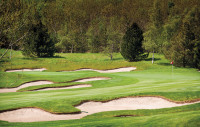
In 2001, an offer that was too good to refuse was made by The Cosgrave Property Group, which expressed an interest in the club's lands and indicated that they would be prepared to relocate the club to a 320 acre site which they had acquired at Ballyman Glen, near Enniskerry, Co. Wicklow.
For historical reasons, the club went back to the Royal Marine Hotel in June of 2002 where the offer was put to the 327 members present and, after a vigorous debate, 79% voted in favour of the move.
Work commenced with Hawtree Ltd supervising the construction of the course to their design. The club eventually moved to Ballyman Glen in August 2007, celebrating its centenary in 2009 with a magnificent course and state of the art clubhouse and facilities. It was a fairytale story and the envy of every club in the country at a time when many were financially falling apart.
Dun Laoghaire won the right to host the Curtis Cup following a competitive bidding process. In being selected, it joined an esteemed list of previous host venues which include Royal County Down; The Old Course, St. Andrews; Royal St. George's; Muirfield and Royal Liverpool.
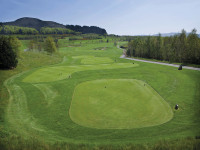
The event was held from 10th-12th June - the same weekend that Euro 2016 began and, despite the clash of dates and the Republic of Ireland football team's involvement in the tournament, fourteen thousand tickets were sold over the three days, beating the previous record set at Nairn in 2012.
Great Britain & Ireland won the 2016 Curtis Cup by 11½ points to 8½ points. It was only their eighth victory since the competition first started at Wentworth in 1932 - although the match has been halved on three occasions.
It was a sunny day back in May when I called to see the Course Superintendent, Des McGann. He was busy preparing for the tournament along with his eighteen staff and, even though it was a Friday morning and just four weeks away to the start, he still managed to give me some of his time to accompany me around the course.
Our first port of call was in and around the maintenance facility. It was amazing to see the amount of equipment on display and there were yet more machines out working out on the course. You only have to see the machinery listed at the end of this article to comprehend the amount of equipment that is at the club's disposal. The mechanic, Brendan Sweeney, was busy in his workshop. He has a standalone building, a short distance from the maintenance facility, dedicated for machinery repairs and maintenance. Each member of staff has their own lock up cage unit where they keep their hand tools and personal protection equipment.

The layout of the course is designed in a very clever way. It is made up of three, nine hole courses - the Upper, Middle and Lower - which can be played in any combination. None of the nine hole courses is less important than the other. Members and visitors check each day which of the two nine hole courses are in play. This makes it very accommodating for Des and his team to carry out special maintenance operations such as coring, verti-draining and sanding where he can work on one of the nine hole courses whilst play continues on the other two nine.
Des began his greenkeeping training at Coláiste Stiofáin Naofa in Cork. He was placed on work experience at Fota Island Golf Club. He got employment at Castle Golf Club serving under both Chris Nolan and Paul Fitzgerald. Whilst with Chris, he was sent to Kinsealy to train for Level 5 greenkeeping.

When an assistant position became available back at his local club in Dun Laoghaire, he applied for the job and was successful. He was assistant to Barry McElroy for fifteen years and, when Barry left to pursue his own career in 2009, Des took over the role of Course Superintendent.
Normally, Des has a total of eight full-time staff, plus a gardener, with an additional seven seasonal workers hired during the summer. However, this year, six months prior to the Curtis Cup, he got an extra three staff and gardener. Included in his full time staff are First Assistant Gavin Dunne, Second Assistant Robert Bolger, Mechanic Brendan Sweeney, Irrigation Technician Tomek Jewula, two qualified greenkeepers and Gardener Kevin Williams.
There are twenty-five hectares of fairways and approaches, 2.8 hectares of greens and 3.2 hectares of tees. "Knowing this makes it much easier to calibrate spray and fertiliser rates," says Des.
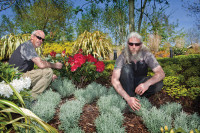
The greens are cored each spring and autumn, using 12mm tines, with sixty tonnes of sand applied each time. Another one hundred tonnes of sand is applied to each of the nine holes every three or four weeks during the growing season. If my maths is correct, this means that 220 tonnes of sand is spread annually on every nine holes!
1500 tonnes of sand is applied to the fairways each year. The predominantly creeping bentgrass greens have been overseeded once last year using Penncross seed (the greens were originally sown with a creeping bent). Granular fertiliser is applied in spring (11:6:9) and autumn (15:2:24), with liquid feeds given in between. The annual fertiliser input for the greens is 150kg nitrogen, 53kg phosphorous, and 200kg potassium. Julian Mooney of Turfgrass is the agronomist at Dun Laoghaire and gives advice to Des. Fairways are given a feed of 22:5:6 in the summer and 15:2:24 in winter (which includes the rough area).
Des applies a growth regulator and liquid iron mix to the fairways and approaches, every four to five weeks in the growing season. The fungicide programme starts in late September or early October with a systemic application given every three or four weeks. A final application is given in spring.
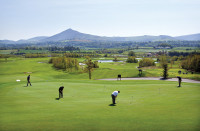
Many of the trees that were planted around the course just after construction have grown beautifully and are blending in very well with the mature trees that have been here since it was open countryside. The younger trees are doing so well that, around four years ago, the club invested in a tree spade to thin out the newer trees and move them to other parts of the course. The advantage of this is that the transplanted trees are being moved into a similar environment to where they were growing, which gives them a much better chance to get established and take root. The transplanting success rate is very high and, going by what I saw on my tour around the course, there are many years ahead of tree lifting.
As you would imagine from a course that is on the edge of 'The Garden of Ireland', wildlife is abundant. If you are up early enough, you will get the opportunity to see deer roaming around the course. They don't do too much damage so Des is not particularly worried about them. Adding wildflower areas around out of play areas of the course is planned for the future.
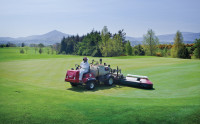
So, what about the preparation of the course for the Curtis Cup? It may only be a three day event, but the preparations have been going on for years. Susan Simpson, Head of Golf Operations with the Ladies Golfing Union (LGU), has been in consultation with Des regarding the course layout. She and the LGU team made their way over to Dun Laoghaire weeks before the match to go through mowing heights, rough management, sorting out pin positions and every other job imaginable in between. The LGU wanted the match to take place on a course playing 6,800 yards. For this reason, the tournament was played on the Upper and Middle courses.
Fairways were mown at 10mm, whilst greens were cut at 2.7mm. The green speed was to be no faster than 10.5 on the stimp. The rough was thickened to 65mm. It all paid off as the home side was victorious.
Great praise for the condition and presentation of the course was given from both sides, but it didn't stop there for Des and his team, as the task of cleaning up after the tournament was the next priority. It was a job well done for the Dun Laoghaire Club greenkeeping staff.

This article, written by Alan Mahon, has been reproduced from Greenside magazine, the official publication of the GCSAI
What's in the shed?
John Deere 220 pedestrian greens
mowers x 10
John Deere 2500 E hybrid mowers (for tees and collars) x 3
Toro Reelmaster 3100D mowers x 2
Toro Greensmaster 3400 triplex mowers x 2
Jacobsen R311T rotary rough mowers x 2
Jacobsen AR250 rough mower
Jacobsen LF3400 fairway mowers x 3
John Deere 1565 front rotary mower
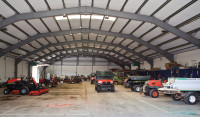
Smithco Tournament Ultra greens iron x 2
Toro 3100D Sidewinder mowers (for tees and greens surrounds) x 3
Toro Workman MDX utility vehicles x 2
Toro Workman HDX-D utility vehicles x 3
Kubota RTV-X900 utility vehicles x 5
Turfco greens topdresser
Dakota greens topdresser
Hardi 400 litre sprayers x 2
Toro Multi Pro 1250 600 litre sprayer
Hardi 1500 litre sprayer
John Deere 5515 tractors x 2
Kubota L5030 compact tractor
Kubota B2410 compact tractor
Kubota STV36 compact tractor
Iseki TH4260 compact tractor

JCB 3CX digger
12 tonne mini digger
John Deere flail mower
Flymo hover mowers x 6
Toro rotary pedestrian mowers x 3
Stihl backpack leaf blowers x 10
Stihl strimmers x 5
Stihl chainsaws x 3
Ryan sodcutter
Charterhouse Multi Spike 1200 slitter
Charterhouse Verti drain 7316 aerator
Imants Shockwave decompactor
Dakota 440 sand spreader
